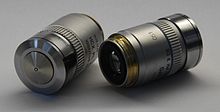

In light microscopy, oil immersion is a technique used to increase the resolving power of a microscope. This is achieved by immersing both the objective lens and the specimen in a transparent oil of high refractive index, thereby increasing the numerical aperture of the objective lens.
Without oil, light waves reflect off the slide specimen through the glass cover slip, through the air, and into the microscope lens (see the colored figure to the right). Unless a wave comes out at a 90-degree angle, it bends when it hits a new substance, the amount of bend depending on the angle. This distorts the image. Air has a very different index of refraction from glass, making for a larger bend compared to oil, which has an index more similar to glass. Specially manufactured oil can have nearly exactly the same refractive index as glass, making an oil immersed lens nearly as effective as having entirely glass to the sample (which would be impractical).
Immersion oils are transparent oils that have specific optical and viscosity characteristics necessary for use in microscopy. Typical oils used have an index of refraction of around 1.515.[1] An oil immersion objective is an objective lens specially designed to be used in this way. Many condensers also give optimal resolution when the condenser lens is immersed in oil.
- ^ "Microscope Objectives: Immersion Media" by Mortimer Abramowitz and Michael W. Davidson, Olympus Microscopy Resource Center (website), 2002.